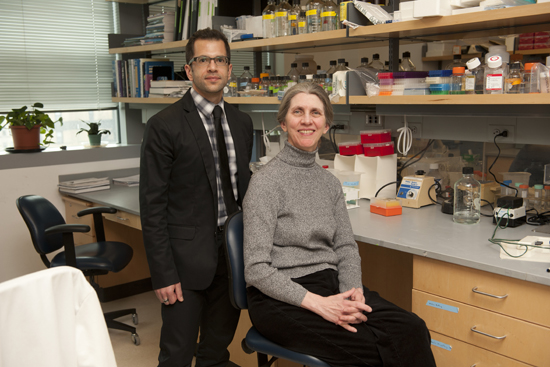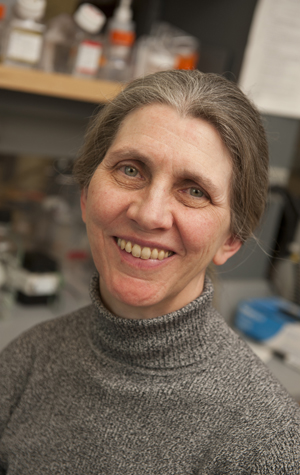Taking On Cancer: Tackling Liver Cancer in the Lab
Dedication, collaboration, and a little luck pay off

CAS researchers Scott Schaus (left) and Ulla Hansen are testing chemical compounds that could lead to a treatment for liver cancer. Photo by Vernon Doucette
In part three of a five-part series, BU Today examines the many ways BU researchers areworking to demystify, treat, and prevent cancer.
Ulla Hansen is a scientist who fell in love with a protein. She began studying it nearly three decades ago as a postdoctoral fellow at MIT because of its potential to solve the mystery of how cells grow. She continued those studies as a faculty member at the Dana-Farber Cancer Institute and Harvard Medical School. And now the College of Arts & Sciences biology professor has discovered that this same protein, transcription factor LSF, also referred to as late SV40 factor, appears to play a role in the growth of liver cancers. Understanding that role could be the key to a treatment for the deadly disease.

“It’s incredibly gratifying personally that all of our basic science all these years has come to a position now where we may be able to translate it into the clinics,” says Hansen, director of BU’s program in molecular biology, cell biology, and biochemistry.
Liver cancer may not garner the media attention that other cancers do, but it is the fifth most common cancer and the world’s third leading cause of death from cancer. And while the rate of diagnosis for other cancers in the United States is declining, diagnosis of liver cancer is rising, largely because of its connection to an increasing incidence of hepatitis C.
The American Cancer Society estimates that almost 29,000 cases of liver cancer will be diagnosed in the United States this year and that nearly as many people will die of the disease. Most victims are in the cancer’s advanced stages before they find out they have it, making the odds of surviving for five years less than 10 percent. Only one FDA-approved chemotherapy exists, but it extends life by a mere two to five months.
Transcription factors like LSF act like a DNA light switch, determining whether a particular gene downstream will be turned on or off. Hansen first came across the protein in the early 1980s in the Phil Sharp Lab at MIT, run by Nobel laureate Sharp, a leader of research in molecular biology and biochemistry. Scientists there were studying how LSF flicks on and off certain viral genes. Hansen later suspected that LSF does a similar job in mammalian cells by helping to control cell growth and division. She was right.
“We’re still trying to figure out all the genes that LSF targets and turns on and off,” she says. “Most transcription factors target at least hundreds of genes, if not thousands.”
For many years, Hansen’s laboratory was the only one in the world to focus on LSF’s role in cell growth and division. It wasn’t unusual for her to get phone calls from scientists around the world wanting to share their own LSF-related discovery.
Devanand Sarkar was one. He called from the Virginia Commonwealth University Institute of Molecular Medicine to tell Hansen that he had found higher levels of LSF in cells after his lab turned on a gene that causes metastasis. “Usually there’s a few thousand LSF entities per cell, but this went up tenfold or twenty-fold,” Hansen says. And when Sarkar looked specifically at liver cancer cells, he saw that the more advanced the cancer had become, the more LSF was present. The two concluded that LSF not only encourages normal cell growth, but also liver cancer cell growth.
That left Hansen wondering if it were possible to ambush LSF in liver cancer cells.

What she really needed, she decided, were some small-molecule inhibitors, or chemical torpedoes, that specifically targeted LSF and disabled it. She found a source in a Nevada company, Sierra Sciences. Researchers there have spent years working on a way to prevent aging (the company motto: Cure Aging or Die Trying) and had toyed with the idea that controlling LSF was key. They had screened 110,000 small-molecule inhibitors and found 80 strong candidates, none of which worked. So they put their work on ice, literally.
When Hansen got in touch with the company about a possible collaboration, the chief scientific officer offered to just send her everything they had.
“I couldn’t believe it,” Hansen says. “This is not the way companies usually act. But they’re not interested in money. They were happy to help.”
After plugging the compounds into liver cancer cells to see if they turned off LSF, Hansen and her team found several encouraging candidates. But they needed more of each compound. Sierra Sciences had included the chemical structures for each compound, but she had no idea how to buy more.
“I decided the best option in this nice interdisciplinary building,” Hansen says, referring to BU’s Life Sciences and Engineering Building, “was to go upstairs to ask some nice synthetic organic chemists how they would go about ordering more of these things.”

So she walked up to the chemistry department and started knocking on doors. Scott Schaus’ was the first to open. The two chatted about her research briefly as Schaus typed away on his computer. Then, Hansen recalls, he looked up and asked, “Do you want us to synthesize it for you?”
She accepted the offer immediately.
Schaus, a CAS associate professor of chemistry and bioinformatics, recruited two graduate students to work on the project. One synthesized compounds, the other tested them to see which were most effective at knocking down LSF. Those compounds were then passed along to Hansen’s team, which tested them in liver cancer cells. Together the labs have identified at least three highly effective small-molecule inhibitors, with FQI2 (dubbed “Ficky 2” by the graduate students) the most promising.
Hansen has since tested the compounds in mice with liver cancer cells and seen impressive results. “Our small-molecule inhibitors are in fact knocking LSF down to nothing,” she says. But that’s not the only good news. “We see absolutely no side effects in the mice.”
It now seems that liver cancer cells need LSF to grow, divide, and multiply. Normal cells do not, or at least have found other ways to work around the protein. Hansen is now trying to figure out why.
She and Schaus published their findings this year in the scientific journal Proceedings of the National Academy of Sciences, and they anticipate that it will be the first of many papers. They have also submitted patent applications and a couple of grant proposals to support future research.
“Collaboration here at BU, I must say, is one of the real strengths of this place,” says Hansen, who came here from Harvard in 1998. “It’s so easy to talk to people and collaborate. That doesn’t happen everywhere.”
Tomorrow, in part four of “BU Takes On Cancer,” computers model the path of cancer.
Comments & Discussion
Boston University moderates comments to facilitate an informed, substantive, civil conversation. Abusive, profane, self-promotional, misleading, incoherent or off-topic comments will be rejected. Moderators are staffed during regular business hours (EST) and can only accept comments written in English. Statistics or facts must include a citation or a link to the citation.